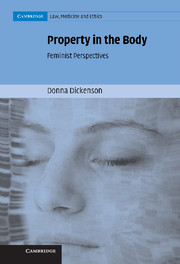Book contents
- Frontmatter
- Contents
- Acknowledgements
- Preface
- 1 Do We All Have ‘Feminised’ Bodies Now?
- 2 Property, Objectification and Commodification
- 3 The Lady Vanishes: What's Missing from the Stem Cell Debate
- 4 Umbilical Cord Blood Banks: Seizing Surplus Value
- 5 The Gender Politics of Genetic Patenting
- 6 Biobanks: Consent, Commercialisation and Charitable Trusts
- 7 The New French Resistance: Commodification Rejected?
- 8 Tonga, the Genetic Commons and No Man's Land
- 9 Afterword
- Bibliography
- Index
2 - Property, Objectification and Commodification
Published online by Cambridge University Press: 15 December 2009
- Frontmatter
- Contents
- Acknowledgements
- Preface
- 1 Do We All Have ‘Feminised’ Bodies Now?
- 2 Property, Objectification and Commodification
- 3 The Lady Vanishes: What's Missing from the Stem Cell Debate
- 4 Umbilical Cord Blood Banks: Seizing Surplus Value
- 5 The Gender Politics of Genetic Patenting
- 6 Biobanks: Consent, Commercialisation and Charitable Trusts
- 7 The New French Resistance: Commodification Rejected?
- 8 Tonga, the Genetic Commons and No Man's Land
- 9 Afterword
- Bibliography
- Index
Summary
This chapter's job is to suggest some preliminary insights from the objectification and commodification of women's bodies, in such a way as to help us to better understand whether all bodies are being made into objects and commodities by the new biotechnologies. I have argued that there is a parallel between the historical ways in which women's bodies have been made objects and the ‘new enclosures’ in bioethics and biotechnology. A comprehensive history or typology of women's objectification and commodification is impossible in a single chapter; nor do I view the task before me as exclusively historical. Rather, the concepts that will help us to analyse and combat objectification and commodification of the body in both sexes come not only from practice, but also from theory. By viewing the ‘new enclosures’ through the prism of women's social entitlements and feminist theory, we will gain important insights into the interrelationship between personal and property rights, the extent to which agency can survive objectification of the body, the limitations of informed consent and the nature of self-ownership. These all have ramifications for property in human tissue and the human genome, and later chapters will draw on them. Very few commentators on bioethics or biolaw have traced the historical roots of modern attitudes about biotechnology and property in the body to canonical political theorists and the historical circumstances in which they wrote. That, I hope, is a novel achievement of this chapter.
- Type
- Chapter
- Information
- Property in the BodyFeminist Perspectives, pp. 26 - 57Publisher: Cambridge University PressPrint publication year: 2007



